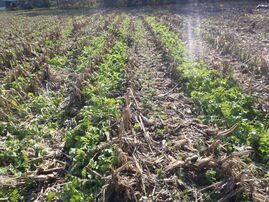CONSERVATION CORNER
A weekly blog for all things conservation
 By: Kevin Brown, BCCD In case you missed last week’s meeting, I will give a quick overview of some of the information that was gone over at the meeting. First off, ANYONE that owns a farm animal needs to have a Manure Management Plan. Period. One chicken, one cow, one horse, etc. Now before you go getting all jacked up, it is easy as pie to do. We all know of an operation somewhere that only has a few animals and they are having a huge impact on the stream. (That’s PC for what’s really going on). This is why it applies to anyone having a farm animal. Now, if you want to write the plan yourself, go to www.paonestop.psu.edu and you have the ability to write your own plan. You do not need to send it in anywhere. No one needs to verify it. You just keep it, and keep records on where your manure goes. If you have any questions, contact me and I will help you work through it. For an operation with only a few animals, it won’t take long at all. And, if DEP or the Conservation District stops for any reason, it will be the first thing they ask for. It is law. Now, I gave a presentation on fixing Animal Concentration Areas (ACA) cheaply and easily. The take-home message is this- we need to keep water and manure (and any lose soil) away from each other. You can have these bare, trampled up areas, but NOT anywhere near any surface water. So, if you have these areas they need to be located in the right spot or moved to the right spot. That is the simplest fix. It doesn’t need to be a big deal. If the stream is their water source, we can help you with some funding to get you another water source. Besides, there is research out there that shows cows do NOT like drinking from a stream (and they shouldn’t be). In Virginia, they took several pastures and just added waterers into the area. Guess what? The cows went to the waterer almost 80% of the time. They like clean water too, and the stream is not clean if they are standing in it. Also, fertilizer is going to be extremely expensive this year. Like, what isn’t? I could show you that by managing your pastures correctly, you could add $50,000 to your bottom line (based on 30 cow/calf pair and 15 growers). $50,000. You can claim that, or throw it away, it’s up to you. Personally, $50,000 sounds like a lot of money to me.
Secondly is cover crops. Again, the point of the presentation is this- We have struggled for a couple years now to grow really good cover crops. If you get the cash crop off early and plant the cover crop early, you will have a nice crop. It sounds easier than it is. Getting it off early has been a challenge. If you cannot, planting the cover crop into the standing corn early in the year appears to work the best (knee high corn). We have tried it at the end of the growing season for a couple years now, and it does not work consistently. You need well-drained soil, good fertility (preferably manure), and a very small amount of tillage. You are trying to grow a crop when crops aren’t supposed to grow. You need to give it an advantage. Planting early into the crop seems to work best. We had great success last year doing this. No-till. No-till has several advantages to it. The majority of farmers in the northeast are now using it, at least in certain circumstances. We use it for our gardens also. The biggest advantage is that it is a LOT less work. For crop work- less time, less equipment, less trips over the field, no rock picking, less weeds, and way better soil health (for a number of reasons). The thing I highlighted at this meeting was the ability to significantly change your rotations and fields to something that may be a lot more user friendly. No till reduces erosion immensely. It opens the door for a lot of other possibilities. I am out of space so if you have questions on this, please give me a call.
0 Comments
Leave a Reply. |
AuthorsVarious staff at the Bradford County Conservation District Archives
July 2024
Categories
All
|
|
Bradford County Conservation District
Stoll Natural Resource Center 200 Lake Road, Suite E | Towanda PA 18848 Phone: (570)-485-3144 |
